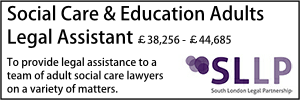Hoarding and mental capacity
- Details
A recent Court of Protection ruling is important reading for the wide range of practitioners dealing with hoarding cases, write Julia Jones and Kate Hicks.
What is Hoarding? Hoarding is defined as the acquisition of, and inability to discard, items even though they appear (to others) to have no value and is a recognised mental disorder. The impact of hoarding can have very serious consequences, both for the individual themselves and others. It can create a number of complex problems for housing and other professionals. Issues of hoarding and mental capacity may arise in the context of decisions about where a person should live, issues relating to their tenancy, the care and support they need.
In AC and GC [2022] EWCOP 39 the Court of Protection recently considered the issue of hoarding, mental capacity and best interests. The question for consideration by the Court was whether AC, a 92-year-old lady, should return to her home on a trial basis. Both AC and GC had been diagnosed with a hoarding disorder. The local authority was concerned that hoarding continued to present a serious health and safety risk due to the volume of items in the property and felt that she should continue to reside in the care home due to the associated risks of self neglect.
When considering hoarding and mental capacity, as with any other capacity decision under the Mental Capacity Act 2005, it is essential to consider the precise decision that needs to be taken and the relevant information to that decision. The case is helpful in that the Court considered the information relevant to making decisions in respect of one’s items and belongings:
- Volume of belongings and impact on use of rooms: the relative volume of belongings in relation to the degree to which they impair the usual function of the important rooms in the property for you (and other residents in the property) (e.g. whether the bedroom is available for sleeping, the kitchen for the preparation of food etc). Rooms used for storage (box rooms) would not be relevant, although may be relevant to issues of 3 and 4 below.
- Safe access and use: the extent to which you (and other residents in the property) are able or not to safely access and use the living areas.
- Creation of hazards: the extent to which the accumulated belongings create actual or potential hazards in terms of the health and safety of those resident in the property. This would include the impact of the accumulated belongings on the functioning, maintenance and safety of utilities (heating, lighting, water, washing facilities for both residents and their clothing). In terms of direct hazards this would include key areas of hygiene (toilets, food storage and preparation), the potential for or actual vermin infestation and risk of fire to the extent that the accumulated possessions would provide fuel for an outbreak of fire, and that escape and rescue routes were inaccessible or hazardous through accumulated clutter.
- Safety of building: the extent to which accumulated clutter and inaccessibility could compromise the structural integrity and therefore safety of the building.
- Removal/disposal of hazardous levels of belongings: that safe and effective removal and/or disposal of hazardous levels of accumulated possessions is possible and desirable on the basis of a “normal” evaluation of utility.
It was agreed in this case that both AC and GC lacked capacity to make decisions about their items and belongings. As a result, best interests decisions were made which meant that house-clearing and cleaning services could enter the property to dispose of perished items and to either remove to storage or dispose of hazardous levels of belongings.
The Judge concluded that whilst a trial at home was not without risk, the risk was manageable. The Judge took into account the concern of the Local Authority that there was a real risk that the care package being put in place would break down due to, amongst other matters, the issue of hoarding. However, AC had expressed a strong desire to return home and it was noted her son had agreed to a list of conditions, which are attached to the judgment. These included allowing access of carers, agreeing to cleaning of the property and monitoring. The Judge took account of her “strong desire to continue to live with her son, who moved back home to help care for her when her husband died, some 11 years ago, where she has familiar things around her, which takes on an even greater significance with someone who is likely to have a hoarding disorder herself”.
This case highlights the large number of professionals involved in matters of hoarding. In this case district Nursing, Occupational Therapy services, electricians and Fire Services are noted to have been involved with assessing the wider safety considerations. A therapist was involved in providing therapy to GC for his own mental health conditions and hoarding. The social worker was complimented for her professional approach to AC. Potential care agencies had assessed whether they could provide support to AC, given the issue of hoarding. The emergency services had originally been involved when they conveyed AC to hospital and reported the conditions in which she had been living. The Office for Public Guardian was also involved as they had made an application to revoke the Lasting Power of Attorney that GC held for AC.
Matters relating to hoarding can be notoriously difficult to unpick, particularly for landlords who may feel that they have only very blunt instruments, such as the advancement possession proceedings, to deal with these cases. Often eviction is the very last resort and this case once again confirms the importance of multi-agency working and the benefit of seeking solutions which can often be seen as a little outside the box but mitigating high levels of potential risk.
Julia Jones is a Partner and Kate Hicks is a Senior Associate at Bevan Brittan.























































